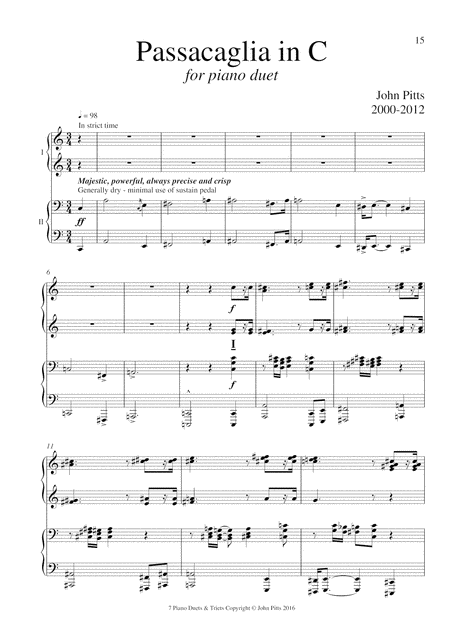Instrumental Duet Instrumental Duet,Piano - Level 5 - Digital Download SKU: A0.890701 Composed by John Pitts. Baroque,Contemporary. Score and parts. 36 pages. Intensely Pleasant Music #3424663. Published by Intensely Pleasant Music (A0.890701). Passacaglia (2000-2012) duet 6 minutes This piece also exists in versions for organ (my original version in 2000) and orchestra (performed by Bristol University Symphony Orchestra under the baton of John Pickard in 2001). The piano duet version was finally completed in 2012. The theme is based on the ground bass from Bach’s stonking Passacaglia in C minor for organ. However, the implied harmonies of Bach’s original ground bass are treated to some twisted harmonies – where each chord is altered using a system of harmonic substitution - swapping each chord implication for a newly chosen one (Cm=C, Fm=F#, G=A, Dm=A¨, Eb=F and on it goes around the 12 chromatic notes). Each key therefore has a ‘dominant’ and ‘subdominant’ that are not the actual chords V and IV in that key, so the traditional cadences and chord relationships are supplanted by 12 individual 3-chord relationships – one set of three chords for each of the 12 (now almost exclusively major) keys. In an attempt to recreate the pulls of the traditional tonic-dominant-subdominant relationships, each key then also has a particular mode/scale with particular added notes that are designed to recreate the sense of moving away from and back towards the home chord of that key. This results in a lot of rich added harmonies and some idiomatic voice-leading. Bach’s original theme in Cm is: C G - E¨ F - G A¨ - F G - D E¨ - B C - F G - C, and in the opening statement of the ground bass this has become: C A - E F# - A B¨ - F# A - D# E - C# C - F# A - C. There are then 21 variations which modulate through a range of keys, during which the ground bass is constantly re-adjusted to fit the new harmonic areas. It starts in C major, then goes through ‘closely’ related keys (eg A major and A¨ major), and then back to C in variations 6, 9 and 11. This kind of arch then happens again but going through more distant keys before returning to C in variations 18, 19 and the final climactic variation 21. Leaving aside the structural and tonal nuts and bolts, my aim was to compose a piece that attempts to recapture some of the nobility and beauty of Bach's Passacaglia, with rich added note harmonies, and exuding an exuberant joy.
